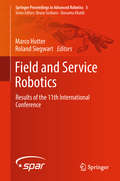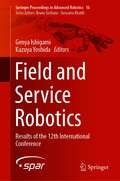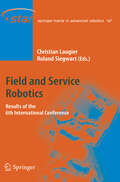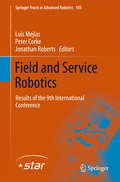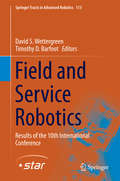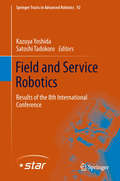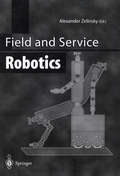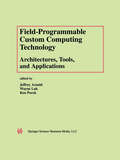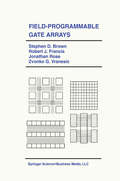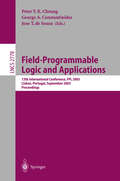- Table View
- List View
Field and Service Robotics: Results of the 11th International Conference (Springer Proceedings in Advanced Robotics #5)
by Marco Hutter Roland SiegwartThis book contains the proceedings of the 11th FSR (Field and Service Robotics), which is the leading single-track conference on applications of robotics in challenging environments. This conference was held in Zurich, Switzerland from 12-15 September 2017. The book contains 45 full-length, peer-reviewed papers organized into a variety of topics: Control, Computer Vision, Inspection, Machine Learning, Mapping, Navigation and Planning, and Systems and Tools. The goal of the book and the conference is to report and encourage the development and experimental evaluation of field and service robots, and to generate a vibrant exchange and discussion in the community. Field robots are non-factory robots, typically mobile, that operate in complex and dynamic environments: on the ground (Earth or other planets), under the ground, underwater, in the air or in space. Service robots are those that work closely with humans to help them with their lives. The first FSR was held in Canberra, Australia, in 1997. Since that first meeting, FSR has been held roughly every two years, cycling through Asia, Americas, and Europe.
Field and Service Robotics: Results of the 12th International Conference (Springer Proceedings in Advanced Robotics #16)
by Genya Ishigami Kazuya YoshidaThis book comprises select proceedings of the 12th Conference on Field and Service Robotics (FSR 2019) focusing on cutting-edge research carried out in different applications of robotics, including agriculture, search and rescue, aerial marine, industrial, and space. It focuses on experiments and demonstrations of robotics applied to complex and dynamic environments and covers diverse applications. The essays are written by leading international experts, making it a valuable resource for researchers and practicing engineers alike.
Field and Service Robotics: Results of the 6th International Conference (Springer Tracts in Advanced Robotics #42)
by Christian Laugier Roland SiegwartThis books presents the results of the 6th edition of "Field and Service Robotics" FSR03, held in Chamonix, France, July 2007. The conference provided a forum for researchers, professionals and robot manufacturers to exchange up-to-date technical knowledge and experience. This book offers a collection of a broad range of topics including: Underwater Robots and Systems, Autonomous Navigation for Unmanned Aerial Vehicles, Simultaneous Localization and Mapping, and Climbing Robotics.
Field and Service Robotics: Results of the 9th International Conference (Springer Tracts in Advanced Robotics #105)
by Luis Mejias Peter Corke Jonathan RobertsFSR, the International Conference on Field and Service Robotics, is a robotics Symposium which has established over the past ten years the latest research and practical results towards the use of field and service robotics in the community with particular focus on proven technology. The first meeting was held in Canberra, Australia, in 1997. Since then the meeting has been held every two years in the pattern Asia, America, Europe.Field robots are non-factory robots, typically mobile, that operate in complex and dynamic environments; on the ground (of earth or planets), under the ground, underwater, in the air or in space. Service robots are those that work closely with humans to help them with their lives. This book present the results of the ninth edition of Field and Service Robotics, FSR13, held in Brisbane, Australia on 9th-11th December 2013. The conference provided a forum for researchers, professionals and robot manufactures to exchange up-to-date technical knowledge and experience. This book offers a collection of a broad range of topics including: Underwater Robots and Systems, Unmanned Aerial Vehicles technologies and applications, Agriculture, Space, Search and Rescue and Domestic Robotics, Robotic Vision, Mapping and Recognition.
Field and Service Robotics: Results of the 10th International Conference (Springer Tracts in Advanced Robotics #113)
by David S. Wettergreen Timothy D. BarfootThis book contains the proceedings of the 10th FSR, (Field and Service Robotics) which is the leading single-track conference on applications of robotics in challenging environments. The 10th FSR was held in Toronto, Canada from 23-26 June 2015. The book contains 42 full-length, peer-reviewed papers organized into a variety of topics: Aquatic, Vision, Planetary, Aerial, Underground, and Systems. The goal of the book and the conference is to report and encourage the development and experimental evaluation of field and service robots, and to generate a vibrant exchange and discussion in the community. Field robots are non-factory robots, typically mobile, that operate in complex and dynamic environments: on the ground (Earth or other planets), under the ground, underwater, in the air or in space. Service robots are those that work closely with humans to help them with their lives. The first FSR was held in Canberra, Australia, in 1997. Since that first meeting, FSR has been held roughly every two years, cycling through Asia, Americas, Europe.
Field and Service Robotics: Results of the 8th International Conference (Springer Tracts in Advanced Robotics #92)
by Kazuya Yoshida Satoshi TadokoroFSR, the International Conference on Field and Service Robotics, is the leading single track conference of robotics for field and service applications. This book presents the results of FSR2012, the eighth conference of Field and Service Robotics, which was originally planned for 2011 with the venue of Matsushima in Tohoku region of Japan. However, on March 11, 2011, a magnitude M9.0 earthquake occurred off the Pacific coast of Tohoku, and a large-scale disaster was caused by the Tsunami which resulted, therefore the conference was postponed by one year to July, 2012. In fact, this earthquake raised issues concerning the contribution of field and service robotics technology to emergency scenarios. A number of precious lessons were learned from operation of robots in the resulting, very real and challenging, disaster environments. Up-to-date study on disaster response, relief and recovery was then featured in the conference. This book offers 43 papers on a broad range of topics including: Disaster Response, Service/Entertainment Robots, Inspection/Maintenance Robots, Mobile Robot Navigation, Agricultural Robots, Robots for Excavation, Planetary Exploration, Large Area Mapping, SLAM for Outdoor Robots, and Elemental Technology for Mobile Robots.
Field and Service Robotics
by Alexander ZelinskyJoe Engelberger, the pioneer of the robotics industry, wrote in his 1989 book Robotics in Service that the inspiration to write his book came as a reaction to an industry-sponsored forecast study of robot applications, which predicted that in 1995 applications of robotics outside factories - the traditional domain of industrial robots - would amount to less than 1% of total sales. Engelberger believed that this forecast was very wrong, and instead predicted that the non-industrial class of robot applications would become the largest class. Engelbergers prediction has yet to come to pass. However, he did correctly foresee the growth in non-traditional applications of robots. Robots are now beginning to march from the factories and into field and service applications. This book presents a selection of papers from the first major international conference dedicated to field and service applications of robotics. This selection includes papers from the leading research laboratories in the world together with papers from companies that are building and selling new and innovative robotic technology. It describes interesting aspects of robots in the field ranging from mining, agriculture, construction, cargo handling, subsea operations, removal of landmines, to terrestrial exploration. It also covers a diverse range of service applications, such as cleaning, propagating plants and aiding the elderly and handicapped, and gives considerable attention to the technology required to realise robust, reliable and safe robots.
Field-Based Coordination for Pervasive Multiagent Systems (Springer Series on Agent Technology)
by Marco Mamei Franco ZambonelliMore and more, software systems involve autonomous and distributed software components that have to execute and interact in open and dynamic environments, such as in pervasive, autonomous, and mobile applications. The requirements with respect to dynamics, openness, scalability, and decentralization call for new approaches to software design and development, capable of supporting spontaneous configuration, tolerating partial failures, or arranging adaptive reorganization of the whole system. Inspired by the behaviour of complex natural systems, scientists and engineers have started to adjust their mechanisms and techniques for self-organization and adaption to changing environments. In line with these considerations, Mamei and Zambonelli propose an interaction model inspired by the way masses and particles in our universe move and self-organize according to contextual information represented by gravitational and electromagnetic fields. The key idea is to have the components’ actions driven by computational force fields, generated by the components themselves or by some infrastructures, and propagated across the environment. Together with its supporting middleware infrastructure – available with additional information under http://www.agentgroup.unimore.it – this model can serve as the basis for a general purpose and widely applicable approach for the design and development of adaptive distributed applications.
Field-Coupled Nanocomputing: Paradigms, Progress, and Perspectives (Lecture Notes in Computer Science #8280)
by Neal G. Anderson and Sanjukta BhanjaField-coupled nanocomputing (FCN) paradigms offer fundamentally new approaches to digital information processing that do not utilize transistors or require charge transport. Information transfer and computation are achieved in FCN via local field interactions between nanoscale building blocks that are organized in patterned arrays. Several FCN paradigms are currently under active investigation, including quantum-dot cellular automata (QCA), molecular quantum cellular automata (MQCA), nanomagnetic logic (NML), and atomic quantum cellular automata (AQCA). Each of these paradigms has a number of unique features that make it attractive as a candidate for post-CMOS nanocomputing, and each faces critical challenges to realization.This State-of-the-Art-Survey provides a snapshot of the current developments and novel research directions in the area of FCN. The book is divided into five sections. The first part, Field-Coupled Nanocomputing Paradigms, provides valuable background information and perspectives on the QDCA, MQCA, NML, and AQCA paradigms and their evolution. The second section, Circuits and Architectures, addresses a wide variety of current research on FCN clocking strategies, logic synthesis, circuit design and test, logic-in-memory, hardware security, and architecture. The third section, Modeling and Simulation, considers the theoretical modeling and computer simulation of large FCN circuits, as well as the use of simulations for gleaning physical insight into elementary FCN building blocks. The fourth section, Irreversibility and Dissipation, considers the dissipative consequences of irreversible information loss in FCN circuits, their quantification, and their connection to circuit structure. The fifth section, The Road Ahead: Opportunities and Challenges, includes an edited transcript of the panel discussion that concluded the FCN 13 workshop.
Field Free Line Magnetic Particle Imaging (Aktuelle Forschung Medizintechnik – Latest Research in Medical Engineering)
by Marlitt ErbeMarlitt Erbe provides a detailed introduction into the young research field of Magnetic Particle Imaging (MPI) and field free line (FFL) imaging in particular. She derives a mathematical description of magnetic field generation for FFL imaging in MPI. To substantiate the simulation studies on magnetic FFL generation with a proof-of-concept, the author introduces the FFL field demonstrator, which provides the world’s first experimentally generated rotated and translated magnetic FFL field complying with the requirements for FFL reconstruction. Furthermore, she proposes a scanner design of considerably enhanced magnetic field quality and efficiency. The author discusses the influence of magnetic field quality optimization on the image quality achieved using efficient Radon-based reconstruction methods, which arise for a line detection scheme and based on this optimized design, presents a dynamic FFL scanner assembly.
A Field Guide to Digital Color
by Maureen StoneMaureen Stone's field guide to digital color presents a survey of digital color with special emphasis on those fields important for computer graphics. The book provides the foundation for understanding color and its applications, discusses color media and color management and the use of color in computer graphics, including color design and selecti
Field Informatics: Kyoto University Field Informatics Research Group
by Toru IshidaHere we use the term "field" to refer to a sphere of practical operation, and correspondingly the term "field informatics" describes informatics tools and methodologies that arise in the field. The components of field informatics are description, prediction, design and transfer, and the methods for those components vary widely. For example, we consider the social goal of revitalizing a mountainous area experiencing depopulation and we show how the tools and methodologies of field informatics may be used to describe such situations using remote sensing, biologging, human sensing and ethnography; the effects of various solutions can be predicted using system dynamics and multiagent simulations; the solutions can be designed using inclusive design or participatory design methods; and finally the experience gained can be transferred using case writing and outreach communication.The authors are specialists in diverse areas such as informatics, engineering, agriculture, sociology and pedagogy, and their areas of interest range from environment conservation to social education for international cooperation. They have a particular focus on the environment in southeast Asia and related topics such as large-scale traffic simulations, participatory workshops, inclusive design workshops, distance learning, and intercultural collaboration.This book targets graduate students seeking tools and methodologies for natural observation, field workers engaged in social participation, and researchers and engineers pursuing innovation. The techniques described in the book could also be exploited by government officials to form consensus and develop activities or by non-profit organizations to undertake more effective social programs.
Field Models in Electricity and Magnetism
by Paolo Di Barba Antonio Savini Slawomir WiakCovering the development of field computation in the past forty years, this book is a concise, comprehensive and up-to-date introduction to methods for the analysis and synthesis of electric and magnetic fields. A broad view of the subject of field models in electricity and magnetism, ranging from basic theory to numerical applications, is offered. The approach throughout is to solve field problems directly from partial differential equations in terms of vector quantities.
Field-Programmable Analog Arrays
by AngelRodríguez-Vázquez Leon O. Chua GlennGulak EdmundPierzchalaField-Programmable Analog Arrays brings together in one place important contributions and up-to-date research results in this fast moving area. Field-Programmable Analog Arrays serves as an excellent reference, providing insight into some of the most challenging research issues in the field.
Field-Programmable Custom Computing Technology: Architectures, Tools, and Applications
by Jeffrey Arnold Wayne Luk Ken PocekField-Programmable Custom Computing Technology: Architectures, Tools, and Applications brings together in one place important contributions and up-to-date research results in this fast-moving area. In seven selected chapters, the book describes the latest advances in architectures, design methods, and applications of field-programmable devices for high-performance reconfigurable systems. The contributors to this work were selected from the leading researchers and practitioners in the field. It will be valuable to anyone working or researching in the field of custom computing technology. It serves as an excellent reference, providing insight into some of the most challenging issues being examined today.
Field-Programmable Gate Array Technology
by Stephen M. TrimbergerMany different kinds of FPGAs exist, with different programming technologies, different architectures and different software. Field-Programmable Gate Array Technology describes the major FPGA architectures available today, covering the three programming technologies that are in use and the major architectures built on those programming technologies. The reader is introduced to concepts relevant to the entire field of FPGAs using popular devices as examples. Field-Programmable Gate Array Technology includes discussions of FPGA integrated circuit manufacturing, circuit design and logic design. It describes the way logic and interconnect are implemented in various kinds of FPGAs. It covers particular problems with design for FPGAs and future possibilities for new architectures and software. This book compares CAD for FPGAs with CAD for traditional gate arrays. It describes algorithms for placement, routing and optimization of FPGAs. Field-Programmable Gate Array Technology describes all aspects of FPGA design and development. For this reason, it covers a significant amount of material. Each section is clearly explained to readers who are assumed to have general technical expertise in digital design and design tools. Potential developers of FPGAs will benefit primarily from the FPGA architecture and software discussion. Electronics systems designers and ASIC users will find a background to different types of FPGAs and applications of their use.
Field-Programmable Gate Arrays (The Springer International Series in Engineering and Computer Science #180)
by Stephen D. Brown Robert J. Francis Jonathan Rose Zvonko G. VranesicField-Programmable Gate Arrays (FPGAs) have emerged as an attractive means of implementing logic circuits, providing instant manufacturing turnaround and negligible prototype costs. They hold the promise of replacing much of the VLSI market now held by mask-programmed gate arrays. FPGAs offer an affordable solution for customized VLSI, over a wide variety of applications, and have also opened up new possibilities in designing reconfigurable digital systems. Field-Programmable Gate Arrays discusses the most important aspects of FPGAs in a textbook manner. It provides the reader with a focused view of the key issues, using a consistent notation and style of presentation. It provides detailed descriptions of commercially available FPGAs and an in-depth treatment of the FPGA architecture and CAD issues that are the subjects of current research. The material presented is of interest to a variety of readers, including those who are not familiar with FPGA technology, but wish to be introduced to it, as well as those who already have an understanding of FPGAs, but who are interested in learning about the research directions that are of current interest.
Field Programmable Logic and Application: 14th International Conference , FPL 2004, Leuven, Belgium, August 30-September 1, 2004, Proceedings (Lecture Notes in Computer Science #3203)
by Jürgen Becker Marco Platzner Serge VernaldeField-Programmable Logic and Applications: 11th International Conference, FPL 2001, Belfast, Northern Ireland, UK, August 27-29, 2001 Proceedings (Lecture Notes in Computer Science #2147)
by Gordon Brebner Roger WoodsField Programmable Logic and Applications: 13th International Conference, FPL 2003 Lisbon, Portugal, September 1–3, 2003 Proceedings (Lecture Notes in Computer Science #2778)
by Peter Y. K. Cheung Georg A. Constantinides Jose T. De SousaThis book contains the papers presented at the 13th International Workshop on Field Programmable Logic and Applications (FPL) held on September 1–3, 2003. The conference was hosted by the Institute for Systems and Computer Engineering-Research and Development of Lisbon (INESC-ID) and the Depa- ment of Electrical and Computer Engineering of the IST-Technical University of Lisbon, Portugal. The FPL series of conferences was founded in 1991 at Oxford University (UK), and has been held annually since: in Oxford (3 times), Vienna, Prague, Darmstadt,London,Tallinn,Glasgow,Villach,BelfastandMontpellier.Itbrings together academic researchers, industrial experts, users and newcomers in an - formal,welcomingatmospherethatencouragesproductiveexchangeofideasand knowledge between delegates. Exciting advances in ?eld programmable logic show no sign of slowing down. New grounds have been broken in architectures, design techniques, run-time - con?guration, and applications of ?eld programmable devices in several di?erent areas. Many of these innovations are reported in this volume. The size of FPL conferences has grown signi?cantly over the years. FPL in 2002 saw 214 papers submitted, representing an increase of 83% when compared to the year before. The interest and support for FPL in the programmable logic community continued this year with 216 papers submitted. The technical p- gram was assembled from 90 selected regular papers and 56 posters, resulting in this volume of proceedings. The program also included three invited plenary keynote presentations from LSI Logic, Xilinx and Cadence, and three industrial tutorials from Altera, Mentor Graphics and Dafca.
Field-Programmable Logic and Applications: 10th International Conference, FPL 2000 Villach, Austria, August 27-30, 2000 Proceedings (Lecture Notes in Computer Science #1896)
by Reiner W. Hartenstein Herbert GrünbacherThis book is the proceedings volume of the 10th International Conference on Field Programmable Logic and its Applications (FPL), held August 27 30, 2000 in Villach, Austria, which covered areas like reconfigurable logic (RL), reconfigurable computing (RC), and its applications, and all other aspects. Its subtitle "The Roadmap to Reconfigurable Computing" reminds us, that we are currently witnessing the runaway of a breakthrough. The annual FPL series is the eldest international conference in the world covering configware and all its aspects. It was founded 1991 at Oxford University (UK) and is 2 years older than its two most important competitors usually taking place at Monterey and Napa. FPL has been held at Oxford, Vienna, Prague, Darmstadt, London, Tallinn, and Glasgow (also see: http://www. fpl. uni kl. de/FPL/). The New Case for Reconfigurable Platforms: Converging Media. Indicated by palmtops, smart mobile phones, many other portables, and consumer electronics, media such as voice, sound, video, TV, wireless, cable, telephone, and Internet continue to converge. This creates new opportunities and even necessities for reconfigurable platform usage. The new converged media require high volume, flexible, multi purpose, multi standard, low power products adaptable to support evolving standards, emerging new standards, field upgrades, bug fixes, and, to meet the needs of a growing number of different kinds of services offered to zillions of individual subscribers preferring different media mixes.
Field Programmable Logic and Applications: 9th International Workshops, FPL'99, Glasgow, UK, August 30 - September 1, 1999, Proceedings (Lecture Notes in Computer Science #1673)
by Patrick Lysaght James Irvine Reiner HartensteinThis book contains the papers presented at the 9th International Workshop on Field ProgrammableLogic and Applications (FPL’99), hosted by the University of Strathclyde in Glasgow, Scotland, August 30 – September 1, 1999. FPL’99 is the ninth in the series of annual FPL workshops. The FPL’99 programme committee has been fortunate to have received a large number of high-quality papers addressing a wide range of topics. From these, 33 papers have been selected for presentation at the workshop and a further 32 papers have been accepted for the poster sessions. A total of 65 papers from 20 countries are included in this volume. FPL is a subject area that attracts researchers from both electronic engine- ing and computer science. Whether we are engaged in research into soft ha- ware or hard software seems to be primarily a question of perspective. What is unquestionable is that the interaction of groups of researchers from di?erent backgrounds results in stimulating and productive research. As we prepare for the new millennium, the premier European forum for - searchers in ?eld programmable logic remains the FPL workshop. Next year the FPL series of workshopswill celebrate its tenth anniversary.The contribution of so many overseas researchers has been a particularly attractive feature of these events, giving them a truly international perspective, while the informal and convivial atmosphere that pervades the workshops have been their hallmark. We look forward to preserving these features in the future while continuing to expand the size and quality of the events.
Field-Programmable Logic and Applications: Reconfigurable Computing Is Going Mainstream (Lecture Notes in Computer Science #2438)
by Manfred Glesner Peter Zipf Michel RenovellThe Field Programming Environment: A Friendly Integrated Environment for Learning and Development (The Springer International Series in Engineering and Computer Science #298)
by Steven P. ReissFIELD has been a remarkably successful research project. The ideas first exhibited in the environment now form the basis for most of the current generation of programming environments, including Hewlett-Packard's Softbench, DEC's FUSE, Sun's Tooltalk, Lucid's Energize, and SGI's Codevision. FIELD pioneered the notion of broadcast messaging as a basis for tool integration. Moreover, many of the other tool concepts introduced in FIELD have made their way into these environments. Thus in discussing the FIELD environment, this book actually explains the inner workings of today's programming environments. The book will be valuable for those interested in the development of programming tools and environments, as well as serious users of programming environments. It will also be of interest to anyone undertaking a large software project, both by introducing the software tools needed to work on such a project and by demonstrating the concepts of message-based integration which can be applied to a variety of domains.
Field Quantization
by Walter Greiner Joachim ReinhardtTheoretical physics has become a many-faceted science. For the young stu dent it is difficult enough to cope with the overwhelming amount of new scientific material that has to be learned, let alone obtain an overview of the entire field, which ranges from mechanics through electrodynamics, quantum mechanics, field theory, nuclear and heavy-ion science, statistical mechanics, thermodynamics, and solid-state theory to elementary-particle physics. And this knowledge should be acquired in just 8-10 semesters, during which, in addition, a Diploma or Master's thesis has to be worked on or examinations prepared for. All this can be achieved only if the university teachers help to introduce the student to the new disciplines as early on as possible, in order to create interest and excitement that in turn set free essential new energy. At the Johann Wolfgang Goethe University in Frankfurt we therefore con front the student with theoretical physics immediately, in the first semester. Theoretical Mechanics I and II, Electrodynamics, and Quantum Mechanics I - An Introduction are the basic courses during the first two years. These lectures are supplemented with many mathematical explanations and much support material. After the fourth semester of studies, graduate work begins, and Quantum Mechanics II - Symmetries, Statistical Mechanics and Ther modynamics, Relativistic Quantum Mechanics, Quantum Electrodynamics, the Gauge Theory of Weak Interactions, and Quantum Chromo dynamics are obligatory.
